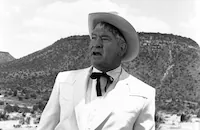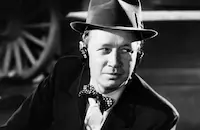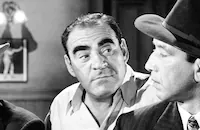Gallant Bess

Brief Synopsis
Cast & Crew
Andrew Marton
Marshall Thompson
George Tobias
Clem Bevans
Donald Curtis
Murray Alper
Photos & Videos
Film Details
Technical Specs

Synopsis
Tex Barton, a sixteen-year-old orphan, works hard to make a success of the stud ranch that his father bequeathed him. Before he died, Tex's father left his son his best mare, Bess, who is now Tex's loyal companion. One day, while visiting his friend Smitty, an elderly man who runs a general store in a nearby town, Tex meets a U.S. Navy recruiter who is looking for young men to sign up for the Navy. Tex, who has never left his farm, is reluctant to join until the recruiter makes an appeal to Tex's sense of patriotic duty. After agreeing to join the Navy's Construction Battalion, known as the Seabees, Tex arranges to have Smitty care for Bess while he is away. Tex is then sent to the U.S. Naval Base at Port Hueneme, California, where he is placed in a training program. As the days pass, Tex grows to miss Bess, and when his unit is finally afforded its first military leave, he goes directly to his ranch to visit her. Following his brief reunion with Bess, Tex returns to his base confident that his mare is being well cared for by Smitty. Tex's confidence is soon shattered, however, when he receives word that Bess is suffering from pneumonia. Tex appeals to his superiors for a leave of absence to tend to his horse, but his request is denied, and he is ordered to wait his turn with the rest of his platoon. Desperate, Tex makes an attempt to escape from his base, only to be captured and jailed by the military police. He is soon released from jail, though, when his entire unit is given a twenty-four hour liberty leave before sailing to the South Pacific. Tex arrives at his ranch too late to save Bess, though and he sadly buries her next to the barn. The tragedy devastates Tex and causes him to resent his commander, Lieutenant Bridgeman, for not allowing him to go home in time to save her. Soon after Tex and his unit arrive at their South Pacific base, Tex happens upon a horse pinned under a fallen tree. With help from some of his Navy pals, Tex frees the horse and tends to its wounds. During the operation to save the horse, Japanese war planes bomb the Navy camp, destroying a tent that only minutes earlier had been occupied by Tex and his pals. Realizing that his men would have been killed were it not for the horse, Bridgeman allows Tex to keep the animal as the unit's mascot. After naming the horse Bess, Tex makes amends with Bridgeman and soon reverts to his old self. One day, when Tex is shot and wounded by a Japanese sniper in the jungle, Bess finds him and carries him back to camp. Tex is treated in sick bay for two weeks, after which he learns that his unit has been ordered back to the States. Tex tries to stay on the island to be with Bess, but his request is flatly denied. However, just as the transport ship pulls away from the island, Bess breaks free from her pen and runs towards the ocean. When Bridgeman catches sight of the horse in the water, he stops the ship and lowers the ramp to allow Bess to join Tex for the voyage home.

Director

Andrew Marton
Cast

Marshall Thompson

George Tobias

Clem Bevans

Donald Curtis
Murray Alper

Wally Cassell

Jim Davis

Chill Wills
John Burford
Johnny Bond
Bess, A Horse

Eddie Acuff
Tom Dillon
Clancy Cooper

Ralph Dunn
Louis Mason
Hank Patterson
Dick Wessel
Pua Kealoha
George Piltz
Charles Bradstreet
Jim Drum
Garry Owen
John Albright
William Roberts
Fred Shellac
Charles Trowbridge
Crew
Peter Ballbusch
Jeanne Bartlett
John W. Boyle
Howard Campbell
Jack Dawn
Capt. W. W. Feinman U.s.n. (ret.)
Cedric Gibbons
Paul Huldschinsky
Harry Komer
Rudolph G. Kopp
Charles O'malley
Harry Rapf
Douglas Shearer
Julian Silberstein
Edwin B. Willis

Photo Collections
Film Details
Technical Specs

Articles
Gallant Bess
Gallant Bess was a respectable hit thanks to its family-friendly story (based on a real-life Seabee incident told by Lt. Marvin Park, USNR) and appealing color photography in the new Cinecolor process, which tended to add a softer blue tone than the dominant Technicolor process. In fact, the look of the film was singled out for praise in Variety, whose reviewer noted that the "ace lensing" of John W. Boyle was "easy on the eyes with perfectly natural hues. There's none of the artificial brilliance of most color films."
After a few years on screen in mostly perfunctory walk-ons and supporting roles, young MGM contract player Marshall Thompson finally got his chance at a lead with this picture. The role failed to catapult him into stardom, and the film was overshadowed by another metro kid-and-pet release with a bigger name cast, The Yearling (1946), starring Gregory Peck and Jane Wyman. Gallant Bess did, however, launch Thompson on a career that was closely tied to animal co-stars up to the end of his life.
His known compatibility with animals got him the part as the orphan farm boy. That same affinity led, years later, to his joining the staff of Ivan Tors productions as producer and director of several short films on animal life. When Tors decided to make the feature-length comedy Clarence, the Cross-Eyed Lion (1965), he cast Thompson as the head of an animal studies center in Africa. The characters and setting were carried over into the hit TV series Daktari, in which Marshall reprised his role as Dr. Marsh Tracy. In 1970, he was the host-narrator of the nature series Jambo, and during this time he directed many episodes of Daktari and the successful Tors-produced TV series Flipper. His other animal-themed work included Zebra in the Kitchen (1965) and George (1971, a comedy about a huge dog, which also became a short-lived TV show). His last feature film appearance was in Sam Fuller's controversial White Dog (1982), about an animal trainer reprogramming a dog trained solely to attack black people.
When he wasn't playing with his furry friends, Thompson also spent considerable time in uniform on screen. His career included such notable war and military-themed films as John Ford's They Were Expendable (1945), Homecoming (1948) with Clark Gable, William Wellman's Battleground (1949), and the biopic of war hero Audie Murphy, To Hell and Back (1955). Thompson also has the distinction of being the director and star of one of the few pro-Vietnam War films, A Yank in Viet-Nam (1964).
Marshall Thompson wasn't the only one on this project with connections to the animal kingdom. Director Andrew Marton eventually went to work for Tors, too, directing episodes of Daktari and Sea Hunt and the feature-length Africa - Texas Style! (1967) and Clarence, the Cross-Eyed Lion. Co-star Chill Wills lent his voice to the lead animal in the popular Francis the Talking Mule film series (beginning in 1950), and he and fellow cast member Clem Bevans also appeared in The Yearling (1946).
Viewers will also recognize veteran comic character actor George Tobias from the TV series Bewitched. But before he was so identified as the long-suffering Abner Kravitz, his career extended all the way back to the 1920s New York stage and included more than 60 film appearances in just about every genre, often as a foil for James Cagney (in seven pictures together).
Director: Andrew Marton
Producer: Harry Rapf
Cinematography: John W. Boyle
Editing: Harry Komer
Art Direction: Howard Campbell, Cedric Gibbons
Original Music: Rudolph G. Kopp
Cast: Marshall Thompson (Tex), George Tobias (Lug), Clem Bevans (Smitty), Chill Wills (Chief Petty Officer), Jim Davis (Harry).
C-100m. Closed captioning. Descriptive Video.
by Rob Nixon

Gallant Bess
Quotes
Trivia
Notes
Working titles for this film were A Man and His Horse, Star from Heaven and Lucky Star. The film contained the following written acknowledgment: "We express our deep appreciation to the United States Navy, and the officers and men of the Advance Naval Base at Port Hueneme, California, for their special cooperation during the filming of this production." A September 1945 Hollywood Reporter news item notes that the film was based on an unpublished story by Lt. Marvin A. Park, as told to Boatswain Arthur L. Parker. According to a September 28, 1945 Hollywood Reporter news item, the picture, which began shooting in "secrecy" in early September 1945, was the first major studio production to be filmed using a color process other than Technicolor. The news item noted that the studio's decision to use Cinecolor ended Technicolor's twenty-year monopoly on film processing at M-G-M. Subsequent M-G-M color productions of the 1940s reverted to the use of Technicolor. No reason was given in the news item for the secrecy surrounding the production but the film was not listed in published production charts until mid-October 1945. According to Hollywood Reporter production charts, the horse "Silvership" appeared in the film. It is possible that Silvership was the real name of the horse listed as "Bess" in the onscreen credits. Some filming took place at Sherwood Forest, the Port Hueneme Naval Base in Southern California and in Montague and Dunsmuir, CA.














